Content
Lattice red or clathrus red is a mushroom that has an unusual shape. You can meet him in the southern regions of Russia throughout the season, subject to favorable conditions. The fungus grows singly and in groups. The official name is Clathrus ruber.
Description of the mushroom trellis red
The red lattice belongs to the Veselkovye family and to the group of gasteromycetes or nutrenniks. Has a distant relationship with raincoats. Its main difference from other species is that the spores mature inside the fruiting body under the cover of a dense shell. As it grows, it collapses, and under it a fruit body appears from an unusual lattice mesh with cells of irregular shape, without a leg. Their number varies from 8 to 12 pieces. Most often, the fruit body is red, but in some cases there are specimens of a whitish and yellowish hue.
On the reverse side, the connecting lintels are covered with a greenish-olive spore-bearing mucus, which exudes a concentrated smell of rotting flesh. This helps the fungus to attract the attention of insects, with the help of which it spreads to the surrounding areas. An unpleasant smell is emitted only by those specimens in which the spores are fully ripe. Their specific aroma spreads up to 15 meters around.
The spores of the lattice are red, elliptical, smooth, colorless, thin-walled. Their size reaches 4-6 x 2-3 microns.
The pulp is loose, soft, spongy. It breaks down easily even with little physical impact.
Where the red trellis grow
The red trellis prefers to grow under broad-leaved trees, around which the soil is rich in humus. Also a favorable environment for its germination is a wet litter of fallen leaves and rotting wood residues. In exceptional cases, this species can grow in mixed forests.
The red trellis belongs to the category of thermophilic mushrooms, so it is able to survive only in those regions where the temperature does not drop below -5 degrees, regardless of the season. Therefore, the red lattice can be found in the Krasnodar Territory, the Caucasus and the Crimea, mainly in those places where there is little illumination during the daytime. If the temperature drops below the critical mark, the mycelium of the fungus dies.
Outside of Russia, the red lattice is found in European countries with favorable climatic conditions. Also the area of its distribution is North America, North Africa and the Mediterranean region.
There have also been cases of fungus germination in a greenhouse, when its spores were brought along with the soil. This is how this species came to Siberia, to the city of Gorno-Altaysk.The red lattice mainly grows in single specimens, but under conditions of high humidity and air temperatures above +25 degrees, germination of group plantings is possible.
Fruiting lasts from spring to autumn. In this case, the mushroom germinates only under favorable conditions.
What red lattices look like
As you can see in the photo, the red lattice mushroom has a spherical or ovoid body in the form of a lattice, for which it received its name. But it acquires this form as it matures.
At the initial stage of development, the fruit body of the trellis has a dense red shape with small black blotches, which is located in an ovoid shell of a light shade. Its height is 5-10 cm and its width is about 5 cm.
As it grows, the outer shell breaks and underneath it you can see several independent red petals that are attached to one base. In the process of development, they lean towards the ground and round out, forming a mesh ball, consisting of separate cells connected to each other. The lintels are covered with a jagged toothed fringe of a dense structure, and its shade does not differ from the color of the fruiting body.
The height of an adult mushroom varies between 10-12 cm, and its width is about 8 cm. In the form of a formed lattice, it can persist for 120 days.
Edibility of red trellis
The red lattice belongs to the category of inedible mushrooms, therefore, it should not be eaten, as it is dangerous to health. But hardly anyone can be seduced by such an unusual appearance of the mushroom that they want to try it. And in conjunction with the unpleasant smell of carrion that he exudes, this only strengthens the desire to bypass him.
However, when this species is found, it is strictly forbidden to pluck it, due to its small number. Therefore, in case of a chance meeting with him, it is necessary to inform the environmental institution.
In addition, the red color of the mushroom signals danger, so even not knowing if the edible trellis is red or not is a warning sign.
How to distinguish between red lattices
The unusual appearance of the red lattice will not leave anyone indifferent. Therefore, it is impossible to confuse it with other mushrooms. In addition, there are a number of differences that distinguish it from other species.
Typical signs:
- ovoid light shell;
- red tint of the fruiting body;
- irregular shape of the cells;
- unpleasant putrid smell when ripe;
- lack of a leg;
- scalloped fringes along the edge of the lintels.
Conclusion
The red lattice belongs to the rare species of fungi that are on the verge of extinction. It is of interest only to specialists in order to study its properties. Therefore, when you find it in the forest, it is worth remembering that it is protected by law and is a unique creation of nature, so you should not rip it out of simple curiosity.











